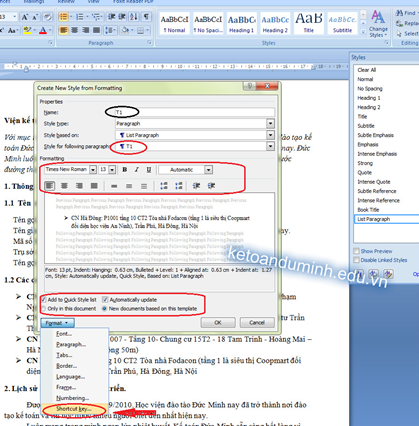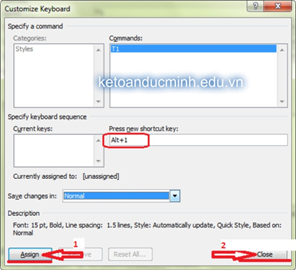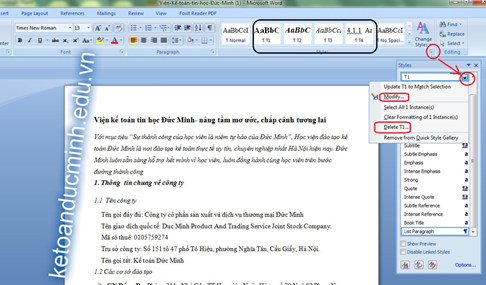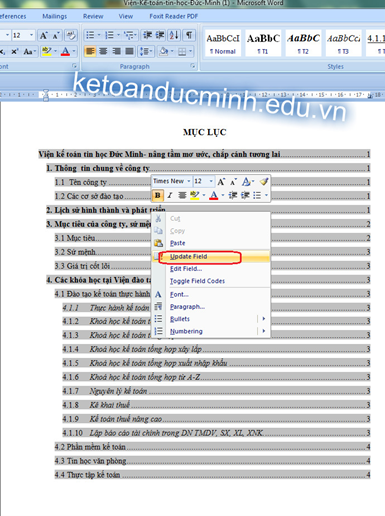Instructions on how to create automatic table of contents in word 2007
Are you making an internship report, dissertation, graduation thesis or simply a long piece of text? Creating a table of contents will help you look at the main content of the paragraph. To save time for you when working with Word, as well as the desire to provide people with additional useful lessons on office computing, TipsMake will reveal more for you one more simple way to create. Automatic table of contents in Word.
Automatic table of contents can save time and effort not only for the person who created the text, but also for the readers of the text to get a better overview of the text. For a hundred-page report, essay, when we need to edit the content or the headline, the layout of the article, you will not have to edit the table of contents anymore. Because the automatic indexing function of Word helps you do this. When you want to open any item in the document, it only takes one simple operation with an automatic table of contents: hold down Ctrl + left click, you will reach the page you want.
In the previous article, we showed you how to make an automatic table of contents by adding a level, or selecting the Heading tab. However, a lot of you have trouble when the change of font format, font size and color is changed unlike your ideas, right? Therefore, today I will guide you to make a quick and automatic table of contents and save time for your future documents as well.
Before creating the table of contents, please add page numbers for the entire document.
I. Step 1: Create typefaces corresponding to each heading
First, to create a table of contents automatically, you must create typefaces corresponding to each heading, title as you like.
1. Open the Word file you want to create the table of contents automatically, and then follow these steps:
2. On the toolbar, in the Home tab, in Styles, click the arrow in the bottom right corner of the Styles section (as shown below).

3. The Styles dialog box appears, click the Create a New Style Icon (as shown in the picture), the Create New Style from Fomarting panel pops up. At this table, you can set the font styles, fonts for the headings at your own discretion.

* In this table, you need to note the following options:
+ Name: Give a name to your typeface. Make it easy to remember (Example: I name the headings T1, T2, T3, T4. T is the first letter of my name. 1,2,3,4 are the headings divided from big to small) )
+ Style for following paragraph: The font you just named depends on the paragraph. (Example: You are creating type T2 (Level 2), you want in the table of contents the small headings will automatically indent 1 less than the larger table of contents, in this box, fill in T1, which means that T2 is in T1 If you want the items to be on the left margin of the text, enter the name of the font you are creating.)
+ Fomatting: Here you can set the font format, font size, font color . as you like.
+ Add to Quick Style list: you should tick here to make your typeface appear in the Styles section of the Home tab
+ Automatically update: When you edit the format of 1 item in the font you've just created, Word will automatically edit the format of all items in that font style.
+ Only in this document: If you check here, the font that you choose will only display in this document.
+ New documents based on this template: (Should choose) the font you just created will be fixed in the Styles section. This is handy when you want to create a table of contents for another document.

In the Fomat box, you can also edit Font, Paragraph format as usual. Also, I will just add 1 tip so you can save more time. Click on the Shortcut key to create a shortcut for the type. Remember, the shortcut you choose cannot match the default shortcut of the computer. I usually choose Alt + lever number (Example: type T1 and Alt + 1) Then click on Assign to complete the shortcut, then OK.

Once completed, you look at the toolbar at the Home tab will see the font that you have just created.
After creating, if you need to edit the style, just right-click on the font on the toolbar, select Modify, or in the Styles dialog box select the style to edit, right-click and select Modify.
With the remaining levels and typefaces, you can do the same as above. You calculate how many levels you need to create in the lesson.

II. Step 2: Assign styles to the corresponding headings.
This stage is quite simple because I previously created shortcuts for styles. You just need to put the mouse in the position of each title and then press the shortcut key.
III. Step 3: Create an automatic table of contents
Click on the position you want to put the table of contents (should create a blank page at the position of table of contents)
- At References tab, select Table of Contents à Insert Table of Contents. The dialog box appears, you choose the following: At the Show level, you enter the number of Styles you have created above. Then click on Options.

- In this dialog box, you delete the numbers 1,2,3 . in the Heading section, scroll down to find the font style you've just found and then enter the numbers 1,2,3 . and OK

So you've created the table of contents automatically.
IV. Step 4: Update the table of contents editing
- Edit: You can edit font format, table of contents as usual as you like. And the result after editing is as follows:

- Update: In the table of contents just created, right-click, select Update Field to update the table of contents. Now every time you change the content in the article, you just need to update the table of contents is done.
+ Update page numbers only: (Only update the page number) If you just edit the content of the text without changing the headings, then tick this box.
+ Update entire table: If you add or remove directories, then check this box to update the entire table of contents.

You should read it
- How to create automatic table of contents effectively in Word 2007
- How to do automatic table of contents in Word 2013, 2016
- Create table of contents automatically in Word 2007 and 2010
- How to create automatic table of contents in Word 2013
- Instructions on how to create automatic table of contents in Word quickly 2020
- How to create automatic table of contents in Word 2016
- How to make a table of contents in Word 2016
- How to create automatic table of contents in Word 2016 simple and fast
May be interested
- Instructions for creating a table of contents automatically in Word
 thuthuatphanmem.vn please show you how to create an automatic table of contents in word.
thuthuatphanmem.vn please show you how to create an automatic table of contents in word. - How to create an image table of contents in Word?
 in reports, dissertations, graduation topics; the writer needs to create a table of contents and link to the text page. in this article, dexterity software will guide you how to create a table of contents for images in word.
in reports, dissertations, graduation topics; the writer needs to create a table of contents and link to the text page. in this article, dexterity software will guide you how to create a table of contents for images in word. - 10 impressive table of contents for Microsoft Word
 if you are working on a long document, you should create a table of contents for viewers to follow. this table of contents will make it easier for anyone to read through the document to grasp the overall content of the text.
if you are working on a long document, you should create a table of contents for viewers to follow. this table of contents will make it easier for anyone to read through the document to grasp the overall content of the text. - How to make a table of contents in Word 2016
 how to make a table of contents in word 2016. an automatic table of contents not only helps you summarize the main content but also helps you easily find the content you want to view. if you do not know how to make an automatic table of contents in word, please refer to the article
how to make a table of contents in word 2016. an automatic table of contents not only helps you summarize the main content but also helps you easily find the content you want to view. if you do not know how to make an automatic table of contents in word, please refer to the article - How to Make Your Word Document Stand Out with a Beautiful Table of Contents
 a well-designed table of contents can set your entire document apart. microsoft word makes it easy to insert a table of contents. then, with just a few simple design tweaks, you can make your table of contents really stand out.
a well-designed table of contents can set your entire document apart. microsoft word makes it easy to insert a table of contents. then, with just a few simple design tweaks, you can make your table of contents really stand out. - Create your own ebook with Microsoft Word
 microsoft word has a lot of good features to make ebooks easy. you can use a variety of styles to format an ebook or change the format to use for different platforms. you can also use the references tool to create an automatic table of contents or create a pre-designed template for repeated use, so you will have more time for the content. the following
microsoft word has a lot of good features to make ebooks easy. you can use a variety of styles to format an ebook or change the format to use for different platforms. you can also use the references tool to create an automatic table of contents or create a pre-designed template for repeated use, so you will have more time for the content. the following - How to make a table of contents in Word 2010
 how to make a table of contents in word 2010. in graduation thesis, thesis ... indispensable for him. table of contents - helps people to grasp and move quickly to the position according to the number of pages in no time. the following article guides you how to make a table of contents in word 20
how to make a table of contents in word 2010. in graduation thesis, thesis ... indispensable for him. table of contents - helps people to grasp and move quickly to the position according to the number of pages in no time. the following article guides you how to make a table of contents in word 20 - How to create and use styles in Word 2016
 style in word helps you format the text uniformly, speed up the formatting of the text, and with the use of style, you can create an automatic table of contents quickly. the following article shows how to create and use styles in word 201
style in word helps you format the text uniformly, speed up the formatting of the text, and with the use of style, you can create an automatic table of contents quickly. the following article shows how to create and use styles in word 201 - Create a new heading in Office 2003
 ms word: next section create automatic table of contents, quantrimang.com continues to introduce more about how to create new heading and how to delete text
ms word: next section create automatic table of contents, quantrimang.com continues to introduce more about how to create new heading and how to delete text - Create a list of tables in Word automatically
 creating a list of tables in microsoft word 2013 is extremely simple. using the list of data is easy to find specific illustrations, images or any data you add in the list.
creating a list of tables in microsoft word 2013 is extremely simple. using the list of data is easy to find specific illustrations, images or any data you add in the list.










 Instructions on how to print 2 sides in excel word
Instructions on how to print 2 sides in excel word How to insert pictures into an Excel comment box
How to insert pictures into an Excel comment box How to insert a fixed image into a cell in excel
How to insert a fixed image into a cell in excel How to format paper sheets before printing in excel
How to format paper sheets before printing in excel Some printing tips are essential in excel
Some printing tips are essential in excel How to restore the view room mode or lose the vertical bar
How to restore the view room mode or lose the vertical bar